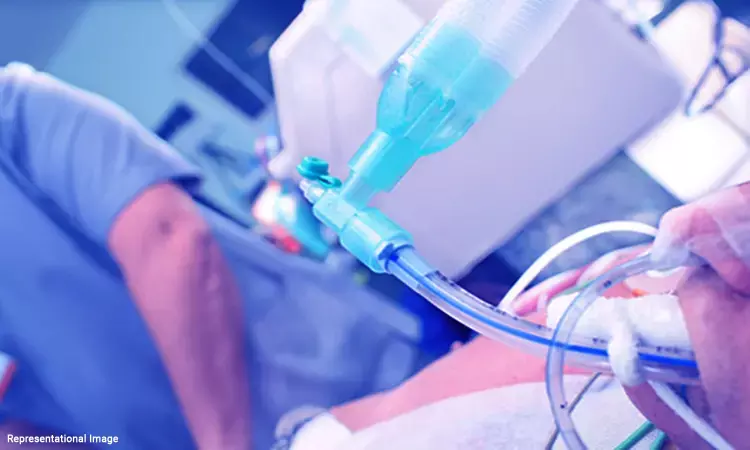- Home
- Medical news & Guidelines
- Anesthesiology
- Cardiology and CTVS
- Critical Care
- Dentistry
- Dermatology
- Diabetes and Endocrinology
- ENT
- Gastroenterology
- Medicine
- Nephrology
- Neurology
- Obstretics-Gynaecology
- Oncology
- Ophthalmology
- Orthopaedics
- Pediatrics-Neonatology
- Psychiatry
- Pulmonology
- Radiology
- Surgery
- Urology
- Laboratory Medicine
- Diet
- Nursing
- Paramedical
- Physiotherapy
- Health news
- Fact Check
- Bone Health Fact Check
- Brain Health Fact Check
- Cancer Related Fact Check
- Child Care Fact Check
- Dental and oral health fact check
- Diabetes and metabolic health fact check
- Diet and Nutrition Fact Check
- Eye and ENT Care Fact Check
- Fitness fact check
- Gut health fact check
- Heart health fact check
- Kidney health fact check
- Medical education fact check
- Men's health fact check
- Respiratory fact check
- Skin and hair care fact check
- Vaccine and Immunization fact check
- Women's health fact check
- AYUSH
- State News
- Andaman and Nicobar Islands
- Andhra Pradesh
- Arunachal Pradesh
- Assam
- Bihar
- Chandigarh
- Chattisgarh
- Dadra and Nagar Haveli
- Daman and Diu
- Delhi
- Goa
- Gujarat
- Haryana
- Himachal Pradesh
- Jammu & Kashmir
- Jharkhand
- Karnataka
- Kerala
- Ladakh
- Lakshadweep
- Madhya Pradesh
- Maharashtra
- Manipur
- Meghalaya
- Mizoram
- Nagaland
- Odisha
- Puducherry
- Punjab
- Rajasthan
- Sikkim
- Tamil Nadu
- Telangana
- Tripura
- Uttar Pradesh
- Uttrakhand
- West Bengal
- Medical Education
- Industry
Dexmedetomidine and ketamine combo has safe and effective sedo-analgesic effect

The purpose of sedation in certain mechanically ventilated patients has traditionally been to keep them calm and comfortable in order to optimise the patient's endotracheal tube tolerance and ventilator synchronisation while undergoing elective post-operative ventilation following major surgery. Inadequate sedation may cause undesirable anxiety, agitation, ventilator asynchrony, and recall in the post-ICU period, hence increasing morbidity. In the critical care unit, titration of analgesics and sedatives is required for every patient. A recently published research compared dexmedetomidine and ketamine in sedoanalgesia for post-operative mechanical breathing after major oncological surgeries.
Randomly, 60 adult surgery patients were assigned into two groups. Group KD (n = 30) got dexmedotomidine combined with ketamine at a rate of 0.5 g/kg/h, whereas Group DEX (n = 30) received dexmedotomidine at a rate of 0.5 mg/kg/h alone. Dexmedetomidine- 0.2-0.7 g/kg/h and ketamine- 0.2-0.7 mg/kg/h were titrated in both groups to achieve the desired sedation. The recording of hemodynamic data, pain ratings, sedation scores, and patient satisfaction. At 2 h and 4 h, pain ratings in the DEX group were significantly greater than in the KD group, which was statistically significant (P 0.05). At the end of 2 hours, the KD group had significantly greater sedation ratings than the DEX group (P 0.05). The ketamine-dexmedetomidine group required shorter time to achieve tracheal extubation than the dexmedetomidine group. Nevertheless, the difference was not statistically significant.
By mixing dexmedetomidine with ketamine, the incidence of hypotension and bradycardia was reduced. The combination of dexmedetomidine and ketamine might be used safely and efficiently as a sedoanalgesic. Dexmedetomidine is a newly produced alpha-2 agonist that has much better selectivity for the 2-adrenoceptor than other commonly used agonists (e.g., clonidine). Ketamine is a dissociative drug that detaches the central nervous system from external stimuli. It offers superior analgesia, sedation, and forgetfulness while maintaining airway reflexes, respiratory effort, and cardiovascular stability. Combination treatment with dexmedetomidine and ketamine is safe and effective for sedation and analgesia in postoperative ICU patients who need elective ventilation assistance. There was a decrease in the incidence of bradycardia and hypotension.
Reference -
Gupta, Bikram K.; Mhaske, Vanita R.1; Pai, Vishal Krishna2; Mishra, L.D., A comparative study of sedo-analgesic effect of dexmedetomidine and dexmedetomidine with ketamine in postoperative mechanically ventilated patients, Journal of Anaesthesiology Clinical Pharmacology: Jan–Mar 2022 - Volume 38 - Issue 1 - p 68-72
doi: 10.4103/joacp.JOACP_234_19
MBBS, MD (Anaesthesiology), FNB (Cardiac Anaesthesiology)
Dr Monish Raut is a practicing Cardiac Anesthesiologist. He completed his MBBS at Government Medical College, Nagpur, and pursued his MD in Anesthesiology at BJ Medical College, Pune. Further specializing in Cardiac Anesthesiology, Dr Raut earned his FNB in Cardiac Anesthesiology from Sir Ganga Ram Hospital, Delhi.
Dr Kamal Kant Kohli-MBBS, DTCD- a chest specialist with more than 30 years of practice and a flair for writing clinical articles, Dr Kamal Kant Kohli joined Medical Dialogues as a Chief Editor of Medical News. Besides writing articles, as an editor, he proofreads and verifies all the medical content published on Medical Dialogues including those coming from journals, studies,medical conferences,guidelines etc. Email: drkohli@medicaldialogues.in. Contact no. 011-43720751


